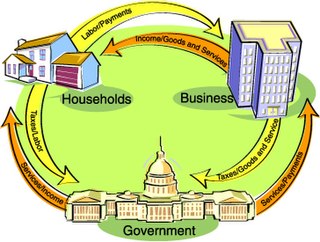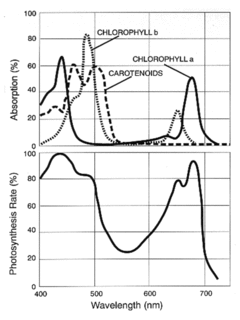
Gross domestic product (GDP) is a monetary measure of the market value of all the final goods and services produced in a specific time period. GDP (nominal) per capita does not, however, reflect differences in the cost of living and the inflation rates of the countries; therefore using a basis of GDP per capita at purchasing power parity (PPP) is arguably more useful when comparing living standards between nations, while nominal GDP is more useful comparing national economies on the international market.
Sustainable Development is the organizing principle for meeting human development goals while simultaneously sustaining the ability of natural systems to provide the natural resources and ecosystem services on which the economy and society depends. The desired result is a state of society where living conditions and resources are used to continue to meet human needs without undermining the integrity and stability of the natural system. Sustainable development can be defined as development that meets the needs of the present without compromising the ability of future generations to meet their own needs.

One can define economic growth as the increase in the inflation-adjusted market value of the goods and services produced by an economy over time. Statisticians conventionally measure such growth as the percent rate of increase in real gross domestic product, or real GDP.

Interest, in finance and economics, is payment from a borrower or deposit-taking financial institution to a lender or depositor of an amount above repayment of the principal sum, at a particular rate. It is distinct from a fee which the borrower may pay the lender or some third party. It is also distinct from dividend which is paid by a company to its shareholders (owners) from its profit or reserve, but not at a particular rate decided beforehand, rather on a pro rata basis as a share in the reward gained by risk taking entrepreneurs when the revenue earned exceeds the total costs.
In mathematics, a recurrence relation is an equation that recursively defines a sequence or multidimensional array of values, once one or more initial terms are given; each further term of the sequence or array is defined as a function of the preceding terms.

The Phillips curve is a single-equation economic model, named after William Phillips, describing an inverse relationship between rates of unemployment and corresponding rates of rises in wages that result within an economy. Stated simply, decreased unemployment, in an economy will correlate with higher rates of wage rises. Phillips did not himself state there was any relationship between employment and inflation; this notion was a trivial deduction from his statistical findings. Samuelson and Solow made the connection explicit and subsequently Milton Friedman and Edmund Phelps put the theoretical structure in place. In so doing, Friedman was to successfully predict the imminent collapse of Phillips' a-theoretic correlation.

Uneconomic growth, in human development theory, welfare economics, and some forms of ecological economics, is economic growth that reflects or creates a decline in the quality of life. The concept is attributed to leading ecological economist and steady-state theorist Herman Daly, though other theorists can also be credited for the incipient idea. Note Uneconomic growth should not be confused with economic degrowth, the reduction of the size of the economy to increase well-being and sustainability.
Planck's law describes the spectral density of electromagnetic radiation emitted by a black body in thermal equilibrium at a given temperature T, when there is no net flow of matter or energy between the body and its environment.

In macroeconomics, aggregate demand (AD) or domestic final demand (DFD) is the total demand for final goods and services in an economy at a given time. It is often called effective demand, though at other times this term is distinguished. This is the demand for the gross domestic product of a country. It specifies the amount of goods and services that will be purchased at all possible price levels.

In heat transfer, Kirchhoff's law of thermal radiation refers to wavelength-specific radiative emission and absorption by a material body in thermodynamic equilibrium, including radiative exchange equilibrium.
The Hodrick–Prescott filter is a mathematical tool used in macroeconomics, especially in real business cycle theory, to remove the cyclical component of a time series from raw data. It is used to obtain a smoothed-curve representation of a time series, one that is more sensitive to long-term than to short-term fluctuations. The adjustment of the sensitivity of the trend to short-term fluctuations is achieved by modifying a multiplier . The filter was popularized in the field of economics in the 1990s by economists Robert J. Hodrick and Nobel Memorial Prize winner Edward C. Prescott. However, it was first proposed much earlier by E. T. Whittaker in 1923.
In energy economics and ecological energetics, energy return on investment (EROI), also sometimes called energy returned on energy invested (ERoEI), is the ratio of the amount of usable energy delivered from a particular energy resource to the amount of energy used to obtain that energy resource.

Photosynthetically active radiation, often abbreviated PAR, designates the spectral range of solar radiation from 400 to 700 nanometers that photosynthetic organisms are able to use in the process of photosynthesis. This spectral region corresponds more or less with the range of light visible to the human eye. Photons at shorter wavelengths tend to be so energetic that they can be damaging to cells and tissues, but are mostly filtered out by the ozone layer in the stratosphere. Photons at longer wavelengths do not carry enough energy to allow photosynthesis to take place.
The Feldman–Mahalanobis model is a Neo-Marxian model of economic development, created independently by Soviet economist Grigory Feldman in 1928 and Indian statistician Prasanta Chandra Mahalanobis in 1953. Mahalanobis became essentially the key economist of India's Second Five Year Plan, becoming subject to much of India's most dramatic economic debates.
In economics, the absolute income hypothesis concerns how a consumer divides his disposable income between consumption and saving. It is part of the theory of consumption proposed by English economist John Maynard Keynes (1883–1946). The hypothesis was refined extensively during the 1960s and 1970s, notably by American economist James Tobin (1918–2002).

Sustainability is the ability to exist constantly. In the 21st century, it refers generally to the capacity for the biosphere and human civilization to coexist. It is also defined as the process of people maintaining change in a homeostasis balanced environment, in which the exploitation of resources, the direction of investments, the orientation of technological development and institutional change are all in harmony and enhance both current and future potential to meet human needs and aspirations. For many in the field, sustainability is defined through the following interconnected domains or pillars: environment, economic and social, which according to Fritjof Capra is based on the principles of Systems Thinking. Sub-domains of sustainable development have been considered also: cultural, technological and political. According to Our Common Future, sustainable development is defined as development that "meets the needs of the present without compromising the ability of future generations to meet their own needs." Sustainable development may be the organizing principle of sustainability, yet others may view the two terms as paradoxical.
In macroeconomics, the cost of business cycles is the decrease in social welfare, if any, caused by business cycle fluctuations.
In the technological theory of social production, the growth of output, measured in money units, is related to achievements in technological consumption of labour and energy. This theory is based on concepts of classical political economy and neo-classical economics and appears to be a generalisation of the known economic models, such as the neo-classical model of economic growth and input-output model.
In economic and environmental fields, decoupling refers to an economy that would be able to grow without corresponding increases in environmental pressure. In many economies, increasing production (GDP) currently raises pressure on the environment. An economy that would be able to sustain economic growth while reducing the amount of resources such as water or fossil fuels used and delink environmental deterioration at the same time would be said to be decoupled. Environmental pressure is often measured using emissions of pollutants, and decoupling is often measured by the emission intensity of economic output.
Econodynamics is an empirical science that studies emergences, motion and disappearance of value—a specific concept that is used for description of the processes of production and distribution of wealth. Econodynamics is based on the achievements of classical political economy and neo-classical economics and has been using the methods of phenomenological science to investigate evolution of economic system. Econodynamics has been proposing methods of analysis and forecasting of economic processes. The comprehensive review of the problems of econodynamics is given recently by Vladimir Pokrovskii.






























